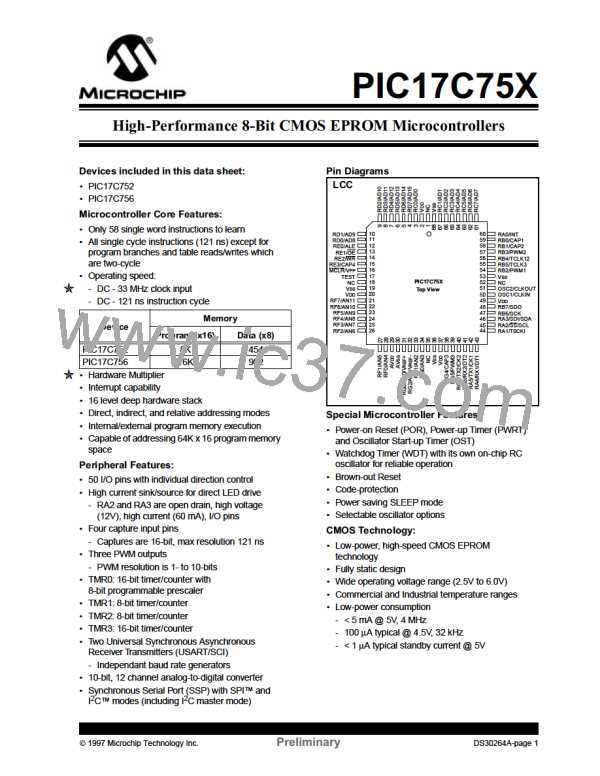PIC17C75X
The ALU is 8-bits wide and capable of addition, sub-
traction, shift, and logical operations. Unless otherwise
mentioned, arithmetic operations are two's comple-
ment in nature.
3.0
ARCHITECTURAL OVERVIEW
The high performance of the PIC17CXXX can be attrib-
uted to a number of architectural features commonly
found in RISC microprocessors. To begin with, the
PIC17CXXX uses a modified Harvard architecture.
This architecture has the program and data accessed
from separate memories. So, the device has a program
memory bus and a data memory bus. This improves
bandwidth over traditional von Neumann architecture,
where program and data are fetched from the same
memory (accesses over the same bus). Separating
program and data memory further allows instructions to
be sized differently than the 8-bit wide data word.
PIC17CXXX opcodes are 16-bits wide, enabling single
word instructions.The full 16-bit wide program memory
bus fetches a 16-bit instruction in a single cycle. A
two-stage pipeline overlaps fetch and execution of
instructions. Consequently, all instructions execute in a
single cycle (121 ns @ 33 MHz), except for program
branches and two special instructions that transfer data
between program and data memory.
The WREG register is an 8-bit working register used for
ALU operations.
All PIC17C75X devices have an 8 x 8 hardware multi-
plier.This multiplier generates a 16-bit result in a single
cycle.
Depending on the instruction executed, the ALU may
affect the values of the Carry (C), Digit Carry (DC), and
Zero (Z) bits in the ALUSTA register.The C and DC bits
operate as a borrow and digit borrow out bit, respec-
tively, in subtraction. See the SUBLW and SUBWF
instructions for examples.
Although the ALU does not perform signed arithmetic,
the Overflow bit (OV) can be used to implement signed
math. Signed arithmetic is comprised of a magnitude
and a sign bit. The overflow bit indicates if the magni-
tude overflows and causes the sign bit to change state.
That is if the result of the signed operation is greater
then 128 (7Fh) or less then -127 (FFh). Signed math
can have greater than 7-bit values (magnitude), if more
than one byte is used. The use of the overflow bit only
operates on bit6 (MSb of magnitude) and bit7 (sign bit)
of the value in the ALU. That is, the overflow bit is not
useful if trying to implement signed math where the
magnitude, for example, is 11-bits. If the signed math
values are greater than 7-bits (15-, 24- or 31-bit), the
algorithm must ensure that the low order bytes ignore
the overflow status bit.
The PIC17CXXX can address up to 64K x 16 of pro-
gram memory space.
The PIC17C752 integrates 8K x 16 of EPROM pro-
gram memory on-chip.
The PIC17C756 integrates 16K x 16 EPROM program
memory.
Program execution can be internal only (microcontrol-
ler or protected microcontroller mode), external only
(microprocessor mode) or both (extended microcon-
troller mode). Extended microcontroller mode does not
allow code protection.
Care should be taken when adding and subtracting
signed numbers to ensure that the correct operation is
executed. Example 3-1 shows an item that must be
taken into account when doing signed arithmetic on an
ALU which operates as an unsigned machine.
The PIC17CXXX can directly or indirectly address its
register files or data memory. All special function regis-
ters, including the Program Counter (PC) and Working
Register (WREG), are mapped in the data memory.
The PIC17CXXX has an orthogonal (symmetrical)
instruction set that makes it possible to carry out any
operation on any register using any addressing mode.
This symmetrical nature and lack of ‘special optimal sit-
uations’ make programming with the PIC17CXXX sim-
ple yet efficient. In addition, the learning curve is
reduced significantly.
EXAMPLE 3-1: SIGNED MATH
Hex Value
Signed Value
Math
Unsigned Value
Math
FFh
-127
255
+ 01h
+
1
+
=
1
=
?
= -126 (FEh)
0 (00h);
Carry bit = 1
One of the PIC17CXXX family architectural enhance-
ments from the PIC16CXX family allows two file regis-
ters to be used in some two operand instructions. This
allows data to be moved directly between two registers
without going through the WREG register. Thus
increasing performance and decreasing program
memory usage.
Signed math requires the result to be FEh
(-126). This would be accomplished by
subtracting one as opposed to adding one.
A simplified block diagram is shown in Figure 3-1. The
descriptions of the device pins are listed in Table 3-1.
The PIC17CXXX devices contain an 8-bit ALU and
working register. The ALU is a general purpose arith-
metic unit. It performs arithmetic and Boolean functions
between data in the working register and any register
file.
1997 Microchip Technology Inc.
Preliminary
DS30264A-page 9

 MICROCHIP [ MICROCHIP ]
MICROCHIP [ MICROCHIP ]